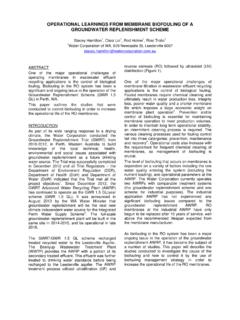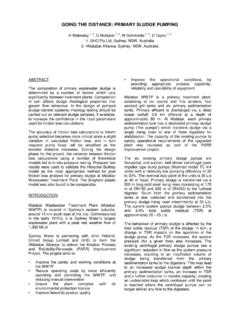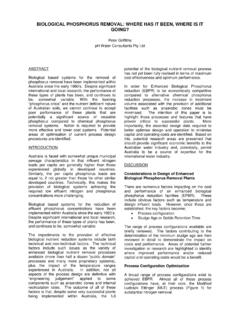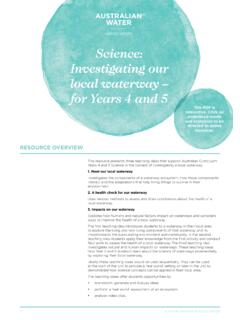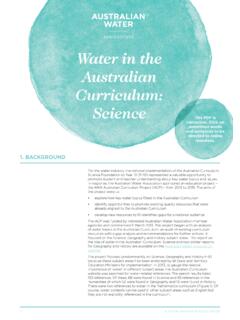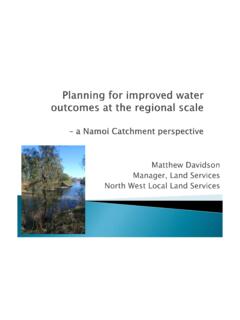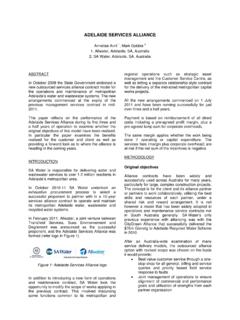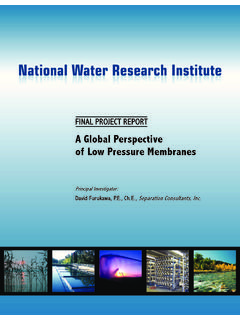Transcription of MBR AND RO TREATMENT OF DAIRY …
1 MBR AND RO TREATMENT OF DAIRY wastewater : industrial water . recycling opportunities . 1 2 2 3 3 2. B. Chapman , N. Goodman , Muster , S. Toze , L. Hodges , J. Sellahewa 1. ADI Systems Asia Pacific, Dunedin, New Zealand 2. CSIRO Land & water Flagship, Clayton, VIC, Australia 3. CSIRO Land & water Flagship, Dutton Park, QLD, Australia ABSTRACT stream, they also offer a reduced cost of discharge to sewer with a reduction in flow as well as nitrogen water is a valuable resource, and commitment to and phosphorus load. environmental sustainability calls for innovative water recycling opportunities . Anaerobic TREATMENT Biological nitrogen removal can be achieved in of food and beverage production wastewater results aerobic TREATMENT systems through the use of in the production of biogas, a renewable source of alternating anoxic (low oxygen) and aerobic energy.
2 However additional steps are required to sections. In the aerobic section the bacteria use the enable water recycling . A membrane bioreactor available oxygen to convert ammonia (NH3) to (MBR) and reverse osmosis (RO) pilot trial, coupled nitrate (NO3), which is known as nitrification. In the with ultraviolet (UV) and chlorine disinfection, anoxic stages a different group of bacteria convert delivered a high quality potable water from nitrate to nitrogen gas (N2), which is released into anaerobic effluent. The MBR achieved 97% COD. the atmosphere, in a process called denitrification. and 95% nitrogen removal, producing permeate A readily available carbon source is required for suitable for direct TREATMENT in the RO.
3 The RO with denitrification to occur. UV and chlorine disinfection achieved potable water criteria. Phosphorus can be removed biologically in aerobic INTRODUCTION systems, through modifying the process to enable bacteria to store phosphorus. Alternatively there are Food production is the largest manufacturing sector various chemical precipitation methods which can in Australia, and consumes large amounts of fresh be employed, either within other TREATMENT water . Even factories with a commitment to processes or as a standalone step. environmentally sustainable practices through implementing water , energy and waste assessment A membrane bioreactor (MBR) system is an programs and resource efficiency processes aerobic process, using modified activated sludge produce wastewater as a by-product.
4 In a DAIRY technology to treat wastewater . A physical factory, these water sources include condensate membrane barrier is used to retain the aerobic from the evaporation of skim milk and other biomass within the TREATMENT plant, rather than products, and membrane filtration permeates gravity settling or other liquid/solids separation amongst other streams. The wastewater contains techniques. The membrane effectively filters the not only organic pollutants (measured as COD), but treated water , which results in a very high quality also nutrients such as nitrogen and phosphorus. final effluent with low suspended solids (often below Various TREATMENT options are available, However detection levels) and low organic content (<5 mg/L.)
5 The used of anaerobic technology results in the BOD). The filtering reduces the need for external production of biogas, a renewable source of energy disinfection operations because bacteria are (Gant et al., 2002). It is important that the correct retained by the membrane, and also means that all type of anaerobic reactor is selected to match the the biomass is retained in the reactor. This results wastewater parameters, and in this case a full-scale in the decoupling of the hydraulic and solids . low rate ADI-BVF reactor was installed and has residence times, as the solids are retained in the successfully treated the DAIRY effluent for many system while water passes through. This means the years. The biogas generated is captured, and used system can have a high hydraulic load rate, and to operate a hot water boiler.
6 Consequently a small reactor size/footprint, while generating a treated effluent that can be directly While the anaerobic reactor successfully reduces treated in a RO unit. the organic pollutants, the levels of nutrients such as nitrogen and phosphorus do not change It is important to have low phosphorus in the MBR. significantly. Therefore while further TREATMENT steps system to manage the formation of calcium offer the ability to generate a reusable water phosphate precipitation and scaling which results in inorganic fouling of the membranes, and also to The membrane tank contained 10 full-size type 510. have low nitrogen levels for reverse osmosis. Kubota membrane cartridges. The design mixed liquor concentration was 10,000 15,000 mg/L.
7 Suspended solids, with a maximum design flow rate While reverse osmosis removes almost all of 2,500 L/day. pathogens, as well as salts and nutrients, final disinfection of the treated water to control residual microbial activity is essential. Potable water is The permeate generated by the MBR was treated typically treated with UV disinfection and sodium directly in the RO unit, which contained a single 4". hypochlorite addition in a combined disinfection x 38" Koch 3838 HRX-VYV polyamide spiral wound process, which has been shown to be more RO membrane (active area, m ). effective than either individually. The RO pilot plant consisted of an inlet filter, feed balance tank, high pressure pump with variable Here we report on a pilot trial demonstrating that speed drive and membrane housing, with a membrane bioreactor (MBR) and reverse osmosis backpressure control valve.
8 The plant was run with (RO) TREATMENT of anaerobic effluent, coupled with an operating pressure of 2000 kPa and a fixed flow ultraviolet (UV) disinfection and sodium rate of 64 L/min. hyphochlorite dosing, produce a high quality potable water which is suitable for recycling within a A WaterTec UV2A disinfection unit, designed to food manufacturing process. treat a maximum flow rate of 6 L/min was used for UV disinfection followed by sodium hypochlorite EXPERIMENTAL CONDITIONS. addition. Sodium hypochlorite dosing was achieved using a metering pump and a %w/w stock The pilot system flow diagram is shown in Figure 1. solution of sodium hypochlorite to achieve a final The MBR consisted of an 800 L pre-anoxic tank, free chlorine residual between and 2 mg/L.
9 1,100 L aeration tank and 600 L post-anoxic tank prior to the 340 L membrane tank. The two-stage RESULTS. denitrification process promotes high levels of nitrogen removal. Mixed liquor from the aeration The MBR demonstrated excellent biological and membrane tanks was recycled to the pre- performance, achieving an average of 97% COD. anoxic tank, recycling the biomass. removal, resulting in less than 40 mg/L COD in the MBR permeate (Figure 2). The ADI-BVF anaerobic reactor effluent was used as a feed for the MBR reactor. Chemical The plant also attained on average 95% nitrogen precipitation was used to reduce the phosphorus removal, resulting in an average total nitrogen level prior to the MBR (Goodman et al.)
10 , 2015), and concentration in the permeate of 21 mg/L. The the average wastewater parameters following nitrogen removal efficiency showed continued phosphorus precipitation are shown in Table 1. improvement through the trial, as the slow growing nitrifying bacteria increased and reached a level of Untreated (raw) wastewater from the factory was maturity suitable for high levels of nitrogen removal. used to provide a carbon source for denitrification in As a result, a total nitrogen concentration of less the anoxic zones of the MBR. The average than 10 mg/L was achieved in the final two weeks. parameters of the raw wastewater are shown in Table 1. In addition to the high level of COD and nitrogen removal, the MBR permeate contained suspend Table 1: MBR influent stream parameters solids concentrations that were below detection levels (data not shown).
